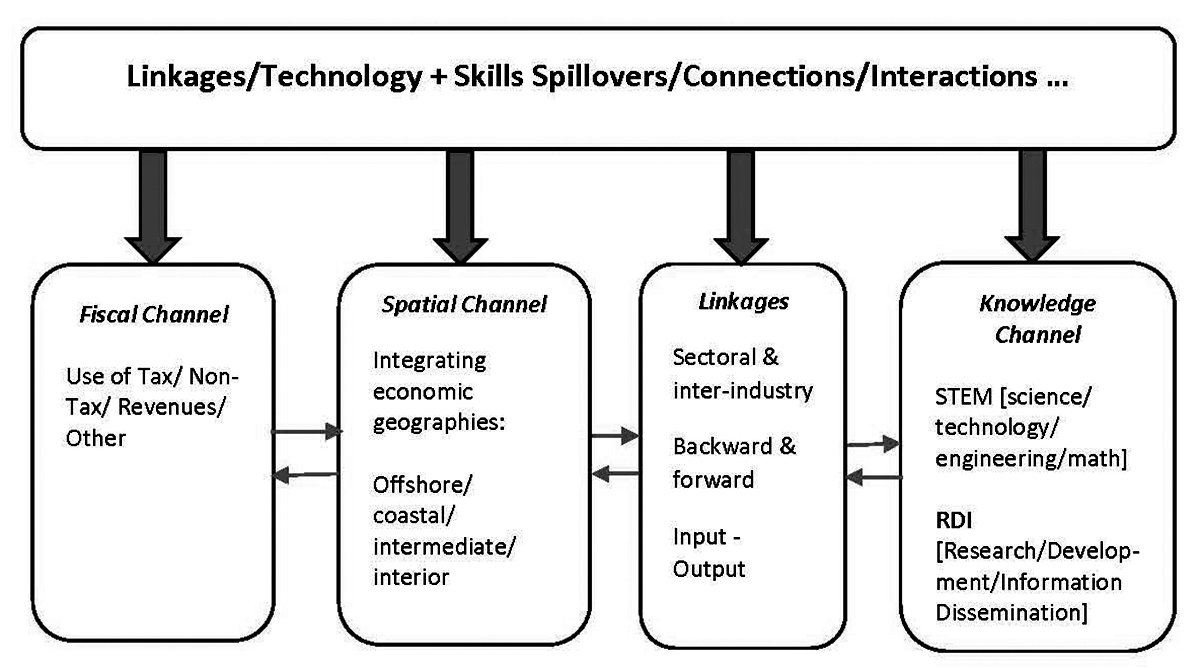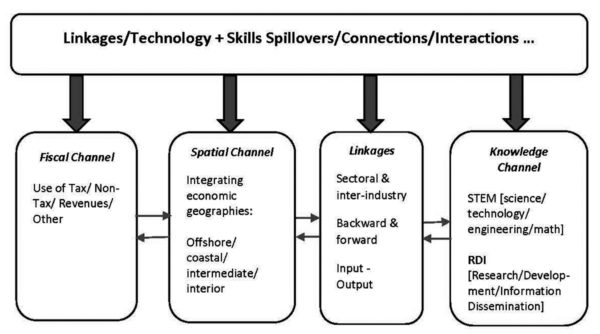In last week’s discussion of Guyana’s proposed local content requirements (LCRs) policy for its coming oil and gas extraction industry, I had introduced three key concepts, which require further elaboration. Those concepts are 1) the enclave economy; 2) the potential for transmission of economic linkages and spillovers from a successful oil and gas industry to the remaining sectors of the economy; and 3) the notion of infant industries. As matters presently stand, these concepts form the cornerstones of government’s rationale supporting LCRs.
There is little doubt that LCRs are indeed required if the country as a whole, is to cope with the challenges of oil and gas extraction. Therefore, today’s column briefly elaborates these concepts, given the central roles they play in the promotion of a LCRs regime.
Enclave economy
There is widespread agreement among economic historians that the notion of an enclave economy has largely evolved out of post-colonial and dependency school economic theorizing, and perhaps, to some extent Marxism. The latter is especially true for our Latin American and Caribbean region.
Simply put, an enclave economy portrays an economic system in which one or more well-capitalized foreign-owned firms extract primary products (including natural resources) for export to the rest of the world (and principally to the region of the firm’s origin) for direct consumption, and/or further processing and re-export. As this occurs, the enclave firm maintains minimal linkages and connections to the rest of the economy, which hosts it.
When the economy is as small as Guyana, it basically ends up in a situation where it produces what it does not significantly consume (either directly or indirectly), and imports what it needs for direct and indirect consumption and investment. Such an enclave economy is not integrated into the rest of the domestic economy, although it remains integrated into the rest of the world.
Furthermore, in relation to the rest of the local economy one finds that the enclave economy crowds out most, if not all, other domestic sectors. Thus, for example, it commands the best of locally available skilled labour.
It also attracts the best of the educated/trained population because of the higher wages it can afford to pay.
Furthermore, one observes that the enclave sector not only pays higher wages and salaries (thereby attracting skilled labour), but as a consequence it achieves higher levels of technology transfer and adaptation. As a rule, it also utilizes far superior technology (indeed one might say global cutting-edge technology) as well as higher ratios of capital to output and investment, than the remainder of the local economy. Regrettably, the local economy is the virtual opposite of this: low capital intensity, low wages, low productivity, low skills, and low technology transfer and adaptation.
Linkages and spillovers
In last week’s column, I had identified the widely used four transmission channels, through which public policy is directed at promoting linkages/spillovers/connections in order to spread the benefits of economic enclaves to the rest of the economy. Schedule 1 attempts to depict these channels graphically.
Thus we have 1) the fiscal channel, through which mobilized state revenues are spent on activities beneficial to the development of the wider economy 2) the spatial channel where these revenues are dedicated to spatial integration. And, for Guyana, this means the integration of its four economic-geographic zones: the offshore, coastal, intermediate and interior clusters. 3) the knowledge channel through which training, education, research & development for the enclave sector benefits the non-enclave sectors; and 4) inter-sectoral and inter-industrial linkages in outputs/inputs/demand between all sectors.
If this occurs, the enclave sector could be integrated, through those channels, with the non-enclave sectors, rather than crowd them out.
Schedule 1: Transmission Channels
Infant industries
Policies to promote the development and expansion of “infant industries” located in the non-enclave sectors are essentially policies favouring protectionism, as an essential ingredient of sustainable development policies.
Typically this protection is designed for application at the early infant stages of business and firm growth; so that these firms/businesses can survive to the stage at which their capacity is strengthened (by economies of scale and scope), allowing them to survive in a competitive environment and consequently benefit, not suffer, from trade expansion.
Based on exchanges in Guyana, the following quote may surprise some readers: Ha-Joon Chang has pointed out that “Almost all of today’s rich countries used tariff protection and subsidies to develop their industries”. Indeed, I shall go further and argue as this series proceeds that, almost all countries, rich and poor, developed and developing, industrialized and non-industrialized, and located in every geographic region continue up to today, to promote the development of their local industries through LCRs.
This is the case, despite the fact that, developing countries are continuously taught (lectured) on the dangers of protectionism.
These dangers are indeed real, and should not therefore be brushed aside. In particular I believe the greatest danger is what economists term as the rise of rent-seeking behaviours. Such behaviours threaten economic progress in all protective environments, because they crowd-out competitive incentives.
Summing-up
I shall have more to say on these three concepts as the discussion proceeds. As readers might have already surmised, although not adequately addressed here, the problematic of LCRs is located at the heart of the great political economy debates, on economic growth, development, globalisation, trade, technology, productivity, and power (in all its dimensions: soft and hard economic, financial, and geo-strategic). This reality applies everywhere, but more specifically for our purposes to Guyana.
In the limited space that these weekly columns afford I always seek to highlight for readers, the need for creative responses to our economic challenges, in order to advance the interests of Guyana in situations where, if truth be told, the greatest danger lies in lack of conscious awareness, thereby allowing misdirection and ignorance, and their peddlers, to prevail.







